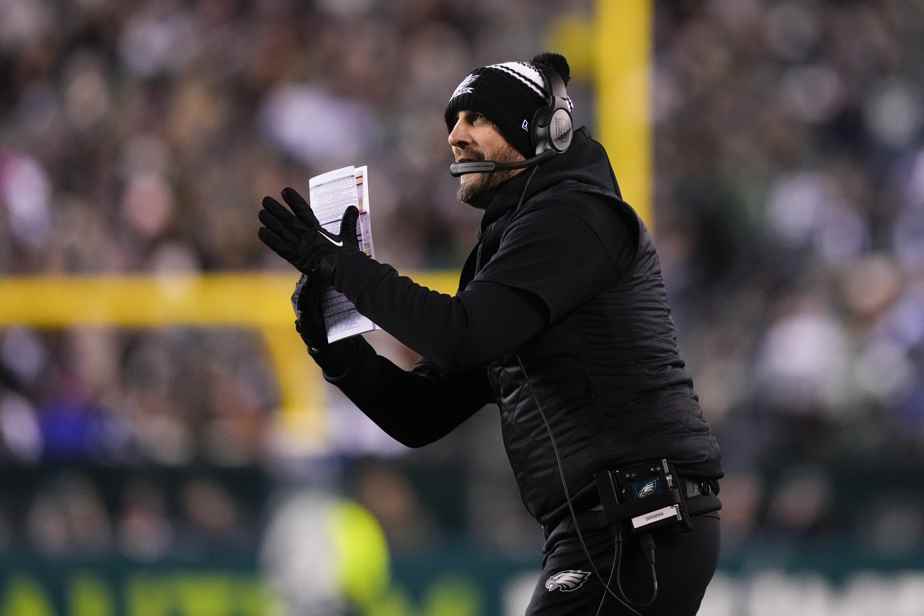But who does what?
“During an NFL game, what is the division of responsibilities between the head coach and the offensive or defensive coordinators? We are often shown on TV the head coach who seems to observe the game on the sidelines, but without seeming to make all the decisions. »
Denis Bouchard
Reply from Nicholas Richard
Like the buried part of an iceberg, the majority of the work done by the head coach is done upstream, away from the spotlight. It is he who motivates the troops, who does the video analysis of the match with the players, who chooses the overall strategies, who defines the identity of the team, who draws the game plan and who manages the training sessions. In other words, he traces the drawing. Then, the coordinators must color said drawing without exceeding, to give life to the work, while following the imposed contours. Usually it is the coordinators who call the games during games. However, it is the head coach who has the last word. Thus, if on a fourth down the offensive coordinator wants to attempt a ground play for a short gain, but the head coach finds it preferable to go for a punt, he is the one who has the last word. During the game, the head coach makes sure that his game plan works and that his assistants stick to it, without interfering in every decision.
What’s that around your neck?

PHOTO ARCHIVE USA TODAY SPORTS
Tony Pollard, Dallas Cowboys
” Good morning ! While watching the football game between Dallas and Tampa Bay, I noticed that some players were wearing something around their necks. [ouvert à l’avant]. Can you tell me what is it and what is it for? »
Annie Jutras
Reply from Nicholas Richard
I’ve been asking myself the same question for the past few weeks. This kind of collar is called the Q-Collar. This piece of equipment worn in particular by Dalton Schultz and Tony Pollard, of the Dallas Cowboys, is in fact a protection to reduce the impact of blows to the head. Since I didn’t study natural sciences in college, it will be easier to explain its benefits using explanations from the US government’s Food and Drug Administration, which has approved its use. The collar exerts pressure on the jugular vein in the neck and is held in place by a metal spring. So, with this pressure, the inflow of blood to the brain is increased. So the blood goes more easily to the skull and this excess blood creates a kind of cushion around the brain. So the shocks are attenuated during contact and that tends to reduce the number, or at least the effects, of concussions.
Up, down?
“In your post-game section, where you see one player up and one down, I would like to understand the principle of this evaluation. Up from what, when? Down from what, when? These two words require comparison. Unless the comparison applies to himself, in which case it would mean that the other players are all equal to themselves! »
Hilaire Bedard
Response from Katherine Harvey-Pinard
It is mainly a question of naming a player who had a good or a less good performance that evening. Obviously, we rely on the past performance of said player to assess whether he is up or down in general in his game. When you say that “that would mean that the other players are all equal to themselves”, it is more or less that. We try to identify a player who has shown superior or inferior efforts or results compared to those he is used to demonstrating.
How long on the ice?

PHOTO DAVID KIROUAC, USA TODAY SPORTS ARCHIVES
Pierre-Luc Dubois, of the Winnipeg Jets, tries to escape David Savard, of the Canadiens.
“I would like to know how the NHL counts the minutes spent on the ice for each player on both teams. It seems quite complicated. »
Pierre Piche
Response from Simon-Olivier Lorange
Despite the introduction of microchips in players’ uniforms, which notably allow television networks to tally up statistics and quickly produce infographics, playing time is still counted by hand by the off-ice officials present at the arena. These spy on the players and record each unit change. In an email, Russell Levine, vice-president, statistics and information, of the NHL, however, told us that these officials are now using the “assistance” of puck and player tracking technologies.
History of contracts
“When a player who was to become an unrestricted free agent signs a contract a year in advance, but is traded in the following weeks or months, does his new contract automatically follow him? »
Jean-Francois Codere
Response from Simon-Olivier Lorange
Yes. When a team acquires a player, they take whatever comes with it, unless their original club agrees to withhold a portion of their salary. For example, if the Canadian immediately traded Jake Allen, his new formation would pay him first under his current contract, but also for the one he has already signed for the next two seasons, at a higher salary. That being said, the scenario is extremely rare, since it is assumed that a player and a team who agree in advance on the terms of a contract are, without making a bad pun, in good short terms. They will therefore probably want to go a long way together.
